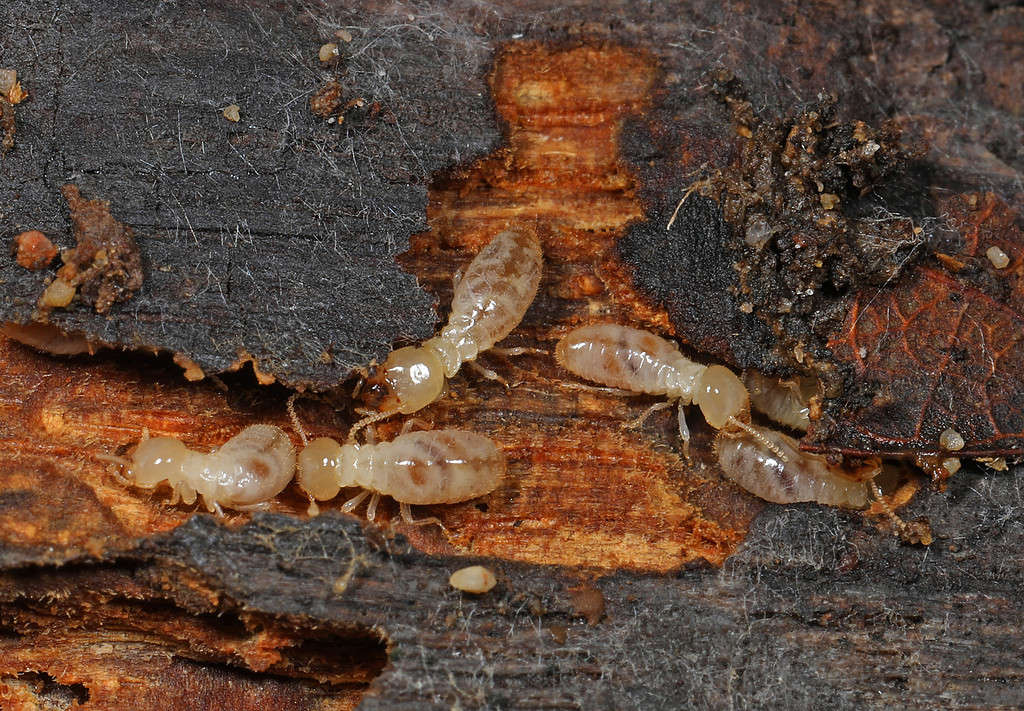Your Utah home could be under attack right now, and you don’t even realize it! Millions of silent but determined and destructive insects could be attacking the very structure of your house. They are called termites, and, in the US, up to $5 billion is spent on their management every year. Termites are six-legged insects with large heads who live in colonies. They evolved to feed on dead trees and woody plants and are able to break down the tough cellulose thanks to microorganisms living in their gut. When humans started building structures from wood, termites considered them legitimate targets, too!
There are thousands of different species, and they live in every part of the world, but we will be focusing a bit closer to home. So, let’s learn more about the types of termites in Utah, the risks they present, and how to prevent them!
What Types of Termites Are Found in Utah?

Eastern subterranean termites are found in Utah.
©Judy Gallagher, CC BY 2.0 – License
There are more than 50 species of termites in North America, but only three are most significant in Utah.
The first is the Eastern subterranean termite, Reticulitermes Hesperus, which is the most common termite in Utah. The second is the arid-land subterranean termite. Subterranean termites eat slowly but constantly and carry food back to their underground tunnels. The third is the dry wood termite. Drywood termites do not live in the ground and do not require ground contact. They often infest new areas via furniture and picture frames. They are the most destructive because they act quickly and extensively in a building.
Currently, you are not required to undergo a termite inspection when selling a house in Utah.
Where in Utah Do You Find Termites?
Overall, termites are active in around three-quarters of Utah over an area stretching from Logan to Salt Lake City and from St George to Moab.
According to a local expert, Utah County provides a great habitat for subterranean termites because it used to be covered in orchards. He writes that ‘between 30 – 40% of the homes in Utah County suffer from some termite damage’. The cities most affected are Orem, American Fork, Springville, and Pleasant Grove.
What Risks Do They Pose?
Termites have caused significant damage to people’s homes. They destroy the wooden elements of the structure. Because wood is often used as a structural component in buildings (meaning that it provides support), termites can even make your home unstable. This happens if termites have damaged support beams, rafters, and even floorboards. In some cases, major repairs are needed. Obviously, this is expensive. However, if the structure of your home is affected, there is the possibility of structural failures, which can cause injuries.
Termites can bite, but they do this very rarely, and the bites do not cause serious risks to humans. However, they do contribute to the spread of molds and fungi. These can both cause allergic reactions in humans and trigger conditions such as asthma. The dust that they create and their droppings can also cause allergic reactions.
How to Check for Termites in Your Home

Mud tunnels are a telltale sign of termites.
©Chaikom/Shutterstock.com
It is not always obvious that you have termites in your home and it is useful to know how to look for them. The areas to focus on are wood-to-soil contact areas or around structural cracks, also, anywhere with increased moisture and joists, porches and crawl spaces, roof eaves and gutters, AC units, and wood piles.
One telltale sign is the presence of mud tunnels that termites create to get from one wooden structure to another. Termite droppings, which look a bit like sawdust, are another sign. You may even spot some discarded termite wings. Sometimes, the first things that alert owners are pinholes in wood and wallpaper and weakened floorboards. At other times, it is a swarm of winged termites.
Subterranean termites can access any wood in contact with soils and are particularly attracted to decaying fungi in rotting wood. Colonies can consist of hundreds of thousands or even millions of individuals, but they can go undetected for up to eight years because they build up so slowly at first. Also, the nest can be up to 20 feet underground!
How Can You Prevent Termite Infestations in Utah?
Here are the best ways to prevent a termite infestation:
- The less wood you have around your home (e.g., wood piles), the better, and try to prevent any wood from being in contact with soil. Wood sidings and stucco need to be at least 6 inches off the ground.
- Seal cracks in the foundations and keep vegetation away from them.
- Reduce moisture by repairing leaking faucets, repairing and cleaning gutters, and fixing leaking roofs.
- Ventilate basements, attics, and crawl spaces to reduce humidity.
- Create a physical barrier on the soil in crawl spaces and under porches using thick plastic sheeting.
The photo featured at the top of this post is © Cheng_Wei/iStock via Getty Images
Thank you for reading! Have some feedback for us? Contact the AZ Animals editorial team.







